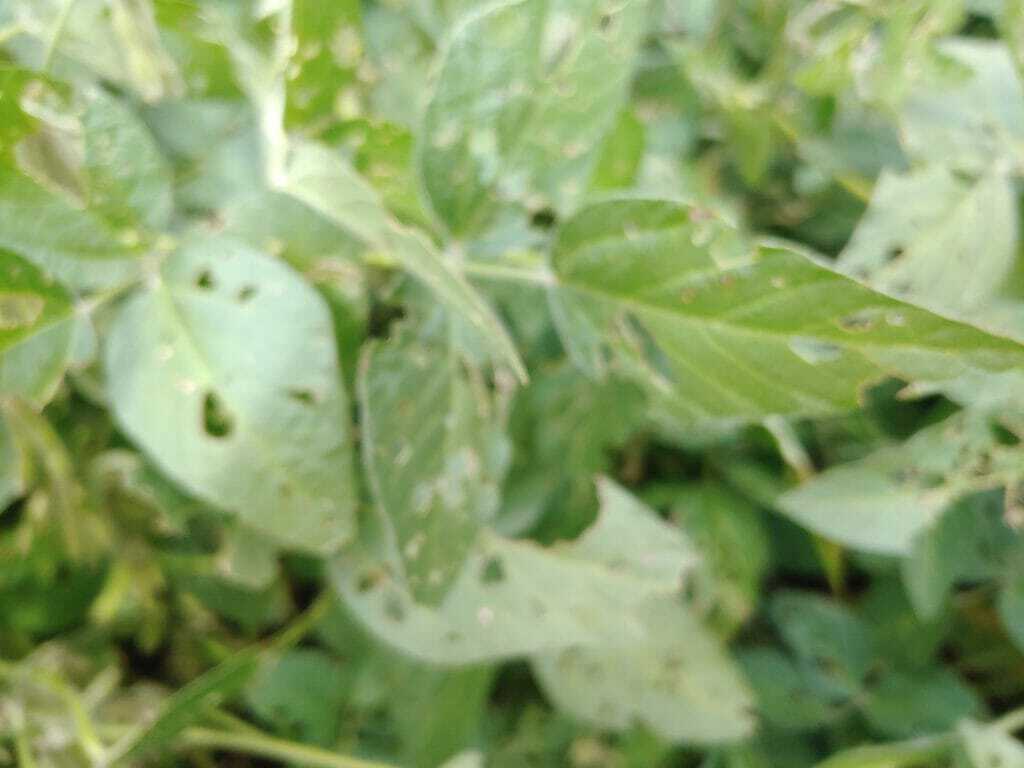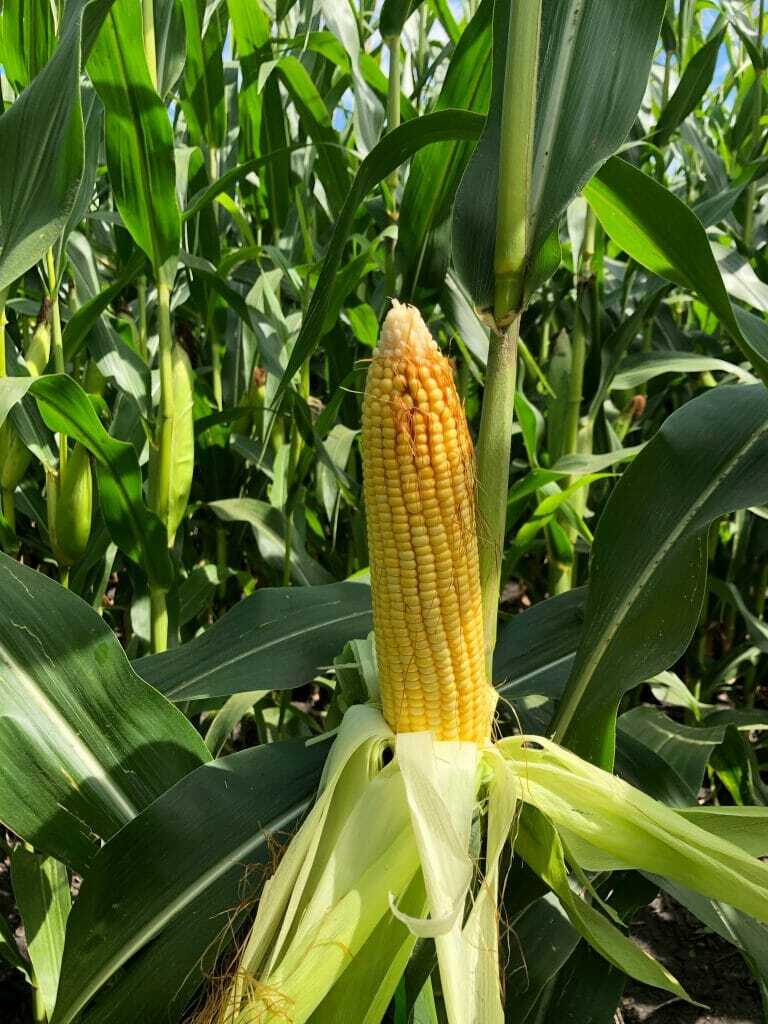September 4, 2019 Crop Reports
Northwest North Dakota
Brian McNamee
What a fantastic Latham® product training week I attended last Thursday in southern Minnesota! We have Latham plots planted across the territory, so contact your local dealer if you’re interested in a first-hand look.
Southeast North Dakota
Gary Geske
After hearing reports of leaf-feeding on soybean fields in the area, I inspected several fields. Every field I walked had leaf feeding, and I found many Green Cloverworms on the ground. Green Cloverworms are one of many soybean defoliators in the Midwest. Using a sweep net method of sampling in an affected area is the best way of checking quantity and life stage of these insects. Many university information reports are available online, but it looks like 20 to 40 percent leaf loss is recommended before insecticide is applied. Check fields soon and spray if needed to maximize yields.
Southeast South Dakota
Ramie Coughlin
The impressive ear pictured here is Latham® 4657 VT2 PRO RIB. It felt like it weighed more than 1 pound!
You can get better yield estimates now by pulling back husks and counting kernels, using the formula (length x rows)/90 = bushel per acre. The rows and kernels are not consistent on the top and bottom of the ear, so start a few kernels up from the bottom and stop a few kernels from the top. Keep in mind that moisture and test weight are not figured into this formula.
Take notes on each product, the environment and the conditions it faced this year. Also keep in mind your original goal for that hybrid back you ordered it a year ago. Then talk with your Latham dealer or regional sales manager about what you’re seeing. Even better, invite him or her to walk a field with you. Field notes can be helpful when selecting products for 2020.
Northeast South Dakota
James Keltgen
Northeast South Dakota finally made it a week without much rain. Some corn is denting, which puts moisture levels around 60 percent. Corn needs, on average, another 30 days to reach black layer. Unfortunately, cooler-than-normal weather is expected again this weekend. Rootworm beetles have been present late this summer, so trait selection will be important next year.
Soybeans are finally filling pods, and some early varieties are starting to turn yellow. There were some fields that were sprayed for bean leaf beetles and clover-worms as defoliation was ever present this year.
Minor defoliation shown above on the new E3 Enlist soybeans.
Pictured below is LH 3937 VT2 PRO is standing out and will be drier than fuller season hybrids this year!
Ken Highness
It’s hard to believe that September is here! Soybeans have great potential in my region as the August rains were beneficial. We’ll see if the pod counts add up at harvest. Pictured is a field of LLGT27 that has the appearance of hail damage. This field actually was damaged by Green Cloverworms, one of many soybean defoliators found in the Upper Midwest. There larvae maybe found in fields from late June through September.
Southern Minnesota
Justin Prokosch
Latham’s new 100-day LH 5077 VT2 PRO looks stout in the plots this year. We just need an ample amount of heat to finish off this year on a good note. This Latham® plot near Echo, MN looks awesome!
Northern Wisconsin
Joe Salter
Two things that never get old, fresh cut hay and these views as Spaeth Farms takes hay off a couple of fields. Last week also brought us some much needed time looking at Latham® product in the field. I really enjoy Latham field training as there’s never a dull moment when our regional sales managers get together.
North Central Iowa
Cory Greiman
This Latham® Soybean SuperStrip plot was planted May 5 near Garner, Iowa. This plot features E3, LLGT27, and LL technologies. Plot seed was treated with SoyShieldTM and ILeVo® and we’re not seeing any signs of SDS or white mold.
Northwest Iowa
Jeremy Joynt
The Clay County Fair in Spencer starts Saturday, Sept. 7. Be sure to stop by and see our Latham® Dealers at booth number 6! The start of the Clay County Fair also means it’s time to check out your combine because harvest will soon be here. It’s important to track which fields need to be harvested first.
Northeast Iowa
Craig Haaland
Pictured here is a nice looking field in Bremer County Iowa of LH 5245 VT2 PRO RIB. After yet another week of very little rainfall, some fields are starting to look stressed. Soybeans have a ways to go yet, so we really could use timely rains and a late frost.
Eastern Iowa
Jerry Broders
“Choice” is a cornerstone of Latham Hi Tech Seeds. No matter what challenges you may have in your soybean fields, we have the soybean for you! We will help you select seed, Field-x-Field® to find the right seed.
Western Iowa
Larry Krapfl
Farmers in western Iowa are getting 24 to 26 tons per acre of silage, which is a bit less than in years without so much rain. Pictured here is a field of Latham’s 5495 3122 EZR.
West North Central Iowa
Bart Peterson
I stopped by to see our Latham® Dealer just south of Badger, Iowa, and got in on the tail-end as he and his son were baling hay pasture. That reminded me that Latham Seeds has trucked several bags of alfalfa in recent weeks for fall seeding. Be sure to check Latham’s full lineup of alfalfa, as well as our corn, soybeans and cover crops. The best price, as well as the best availability, is now!
Central Iowa
Aaron Steenhoek
Pre-harvest plot tours are starting across the territory, and we’re seeing the signs of fall. Corn is shrinking in places and beginning to die unnaturally. Soybean diseases like white mold, SDS, and brown stem rot (BSR) are showing up as soybeans mature. Late-season scouting leads to better seed decisions in the future plus it will help you prioritize fields for harvest. Pictured here is LH 6224, which is showing well in southern Iowa.






















